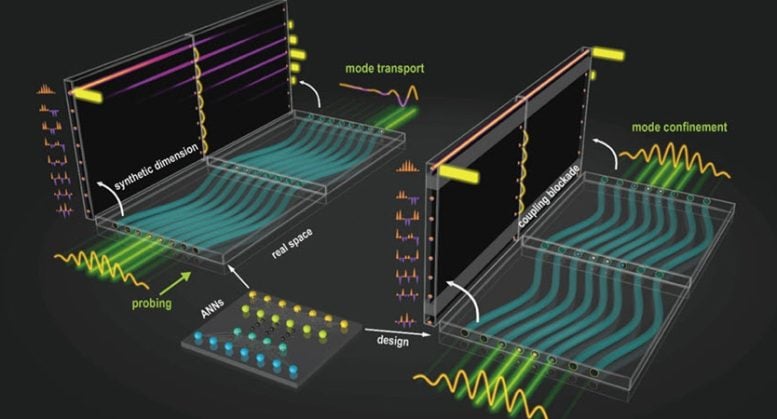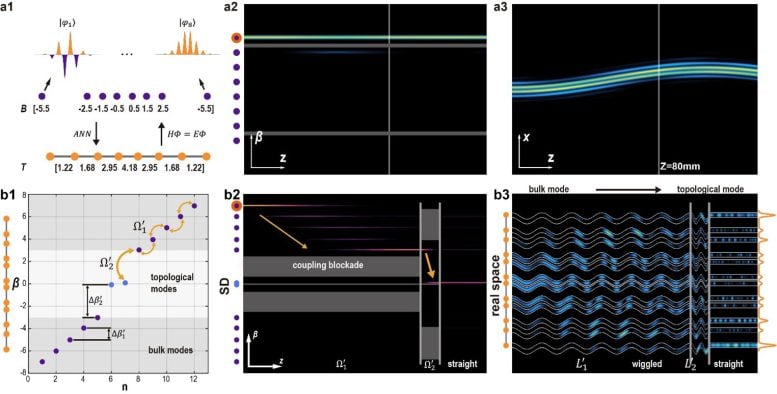
Researchers developed adjustable arrays of waveguides that introduce synthetic modal dimensions, enhancing the management of light within photonic systems. This innovation has potential applications ranging from mode lasing to quantum optics and data transmission.
In the realm of physics, synthetic dimensions (SDs) have emerged as a cutting-edge research frontier, providing a means to investigate phenomena in higher-dimensional spaces beyond our conventional 3D geometry. This concept has gained substantial attention, particularly in topological photonics, due to its potential to reveal complex physics that cannot be accessed within traditional dimensions.
Researchers have proposed various theoretical frameworks to study and implement SDs, aiming at harnessing phenomena like synthetic gauge fields, quantum Hall physics, discrete solitons, and topological phase transitions in four dimensions or higher. Those proposals could lead to new fundamental understandings in physics.
One of the primary challenges in conventional 3D space is the experimental realization of complex lattice structures with specific couplings. SDs offer a solution, by providing a more accessible platform for creating intricate networks of resonators with anisotropic, long-range, or dissipative couplings.

This capability has already led to groundbreaking demonstrations of non-Hermitian topological winding, parity-time symmetry, and other phenomena. A variety of parameters or degrees of freedom within a system, such as frequency modes, spatial modes, and orbital angular momenta, can be used to construct SDs, promising for applications in diverse fields ranging from optical communications to topological insulator lasers.
A key goal in this field is the construction of a “utopian” network of resonators where any pair of modes can be coupled in a controlled manner. Achieving this goal necessitates precise mode manipulation within photonic systems, offering avenues for enhancing data transmission, energy harvesting efficiency, and laser array radiance.
Utilizing Artificial Neural Networks for Waveguide Design
Now, as reported in Advanced Photonics, an international team of researchers has created customizable arrays of waveguides to establish synthetic modal dimensions. This advance allows for effective control of light in a photonic system, without the need for complicated extra features like nonlinearity or non-Hermiticity. Professor Zhigang Chen of Nankai University notes, “The ability to adjust different modes of light within the system brings us a step closer to achieving ‘utopian’ networks, where all parameters of an experiment are perfectly controllable.”

In their work, the researchers modulate perturbations (“wiggling frequencies”) for propagations that match the differences between different modes of light. To do so, they employ artificial neural networks (ANNs) to design waveguide arrays in real space. The ANNs are trained to create waveguide setups that have exactly the desired mode patterns. These tests help reveal how light propagates and gets confined within the arrays. Finally, the researchers demonstrate the use of ANNs to design a special type of photonic lattice structure called a Su-Schrieffer-Heeger (SSH) lattice. This lattice has a specific feature enabling topological control of light throughout the system. This allows them to change the bulk mode in which light travels, showcasing the unique properties of their synthetic dimensions.
The implication of this work is substantial. By fine-tuning waveguide distances and frequencies, the researchers aim to optimize the design and fabrication of integrated photonic devices. Professor Hrvoje Buljan of University of Zagreb remarks, “Beyond photonics, this work offers a glimpse into geometrically inaccessible physics. It holds promise for applications ranging from mode lasing to quantum optics and data transmission.” Both Chen and Buljan note that the interplay of topological photonics and synthetic dimension photonics empowered by ANNs opens new possibilities for discoveries that may lead to unprecedented materials and device applications.
Reference: “Deep-learning-empowered synthetic dimension dynamics: morphing of light into topological modes” by Shiqi Xia, Sihong Lei, Daohong Song, Luigi Di Lauro, Imtiaz Alamgir, Liqin Tang, Jingjun Xu, Roberto Morandotti, Hrvoje Buljan and Zhigang Chen, 18 March 2024, Advanced Photonics.
DOI: 10.1117/1.AP.6.2.026005
8 Comments
Researchers have proposed various theoretical frameworks to study and implement SDs, aiming at harnessing phenomena like synthetic gauge fields, quantum Hall physics, discrete solitons, and topological phase transitions in four dimensions or higher. Those proposals could lead to new fundamental understandings in physics.
Please ask researchers to think deeply:
1. Do you really understand topological phase transitions?
2. Is universal gravitation related to topological phase transitions?
3. Are the synthetic gauge fields, quantum Hall physics, and discrete solitons related to topological phase transitions?
4. Can topological vortices form quantum gravity?
5. Is topological vortex a wave or a particle?
and so on.
Scientific research guided by correct theories can help humanity avoid detours, failures, and pomposity. Please witness the exemplary collaboration between theoretical physicists and experimentalists (https://scitechdaily.com/microscope-spacecrafts-most-precise-test-of-key-component-of-the-theory-of-general-relativity/#comment-854286). Contemporary physics has always lived in a self righteous children’s story world. Whose values have been overturned by such a comical and ridiculous reality?
Please continue performing, there will always be a large audience willing to watch these dirty and ugly things. Is this the children’s story of contemporary physics?
Misguided by the pseudo-scientific theory of Physical Review Letters (PRL), many researchers do not consider the similarities and differences between geometric shapes and physical reality in physics research, but indulge in imagination. Although scientific research can be imagined, it cannot be done recklessly.
Please ask researchers to reflect carefully.
1. Which is more suitable for explaining the physical phenomena (including universal gravitation) we observe in scientific research, topological states or imagined quantum states?
2. What is the physical reality of imagined quantum states?
3. Which is more scientific, imagined quantum states or mathematical topological states?
4. What is the correlation between mathematical graphics and real physical phenomena?
5. What is the space-time basis for the evolution of various shapes in the physical world?
and so on.
Please continue to think:
1. Is the quantum states you imagine high-dimensional matter or low dimensional matter?
2. Is topological vortex high-dimensional matter or low dimensional matter?
3. Can low dimensional matter be the understructure of high-dimensional matter?
and so on.
When you really think about it the nature of the matter doesn’t really matter, because, at least in this article the nature of the universe that that matter might actually exist in wasn’t described, therefore we must assume that the particular dimension that the authors refer to is only hypothetical as well as the fourth dimension that they also refer to; it’s properties were left undefined, so we must assume then that the article concerns itself primarily as a mathematical construct in much the same way that particle physicists use multi dimensional mathematics to describe the behavior of both the particles themselves and the forces that act upon them.
However, in a properly described universe with its accompanied dimensions, we tend to make assumptions that we know from the outset are incorrect; such as constants always being constant. Take for example this very particular universe; this universe then, if it were to have access to a fourth dimension, the third dimension would in all probability be the typological surface of a four dimensional manifold.
For absolute usefulness we can conceive of the case where a sun emits the vast majority of its energy in the form of radio waves, there are in fact suns that emit more energy in that form in one second than this planet’s entire electic production would be in ten thousand years; but those suns aren’t close to us in a three dimensional universe, but in the fourth dimension that sun is right next to us.
Realize that gravity and time are synonymous and that almost or possibly all phenomenon can be described in multiple forms; take the example of curved space-time; we could also describe it as a time varying medium, in which case it becomes obvious that energy and mass are just different forms of time. Some thief jacking with my device, thinks I’m his slave and that he’s some sort of God.
If anyone’s interested get me out of this Mafia hell hole.
VERY GOOD!
Thank you for your understanding and comments. When you really think about it the nature of the matter doesn’t really matter.
However, when you really think about it the nature of the matter is actually very important. Scientific research is even more so. It almost runs through the entire process of scientific research.
Enjoy you every day.
At this point those “physicists” could just be making stuff up and no one would know. Or care.
Thank you, I have seen a finger nail size crystal energetically turned into a 10 foot foofighter, been dreaming about it for years and studying physics in order to find this topic… Thankyou for inspiration to continue my study
I’m hearing you, Liz. Not quite sure what kind of help you need, if surely any. I’d hear more of what you see from where you’re seated. Does the thief think he’s a god relattive-to or apart-from you? Then is it an self-imposed hierarchal position based on an ability to manipulate your device in way that you cannot resist? If you are immersed in mafiosi, is it a matter of trapped, or no Plan B? Did their spatial government eclipse your personal space? I’m trying to make informed decisions here.